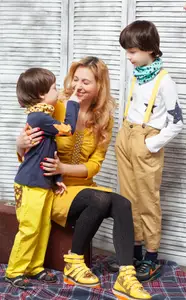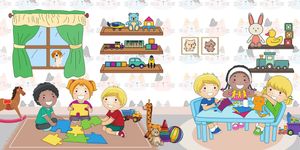First Day of Daycare for a 1-Year-Old:
Essential Tips for a Smooth Transition
The first day of daycare for a 1-year-old marks a significant milestone in both a child’s and parent’s life. This transition can be filled with mixed emotions, from excitement to anxiety. Preparing your 1-year-old for daycare involves establishing routines, familiarizing them with the new environment, and creating a positive association with the experience.

Parents can ease this transition by practicing the daycare routine at home prior to the first day. This includes setting a consistent wake-up time and following a schedule similar to what the child will experience at daycare. It’s also beneficial to spend time at the daycare with your child before their official start date, allowing them to become familiar with the new surroundings while having the comfort of a parent nearby.
Choosing the right daycare provider is crucial for a smooth transition. Parents should consider factors such as the facility’s policies, staff qualifications, and daily activities offered. Engaging 1-year-olds in developmentally appropriate activities at home can also help prepare them for the stimulating environment they’ll encounter at daycare.
Understanding Daycare Transition

Transitioning to daycare can be a significant milestone for both parents and 1-year-olds. This process involves key developmental stages, emotional adjustments, and the use of familiar objects to ease the change.
Developmental Milestones and Daycare
At one year old, children are rapidly developing cognitive and motor skills. Many 1-year-olds are learning to walk or already walking, while others may still be crawling. Daycare environments can support these milestones by providing safe spaces for exploration.
Cognitive development is also in full swing. Children this age are learning to communicate through gestures and may be saying their first words. Daycare staff are trained to encourage language development through songs, stories, and interactive play.
Gross motor skills continue to improve. Daycare activities often include opportunities for climbing, throwing balls, and using push-and-pull toys, which further enhance physical abilities.
Separation Anxiety and Its Management
Separation anxiety is common in 1-year-olds starting daycare. It’s a normal part of emotional development, showing the child has formed strong attachments to caregivers.
To manage separation anxiety:
- Keep goodbyes brief and positive
- Establish a consistent drop-off routine
- Practice short separations before starting daycare
Parents should remain calm during drop-offs, as children can sense anxiety. Daycare providers can help by engaging the child in an activity immediately upon arrival.
The Role of Comfort Items
Comfort items play a crucial role in easing the daycare transition. These objects, often called transitional objects, provide a sense of security and familiarity in the new environment.
Common comfort items include:
- Favourite stuffed animals
- Blankets
- Photos of family members
Daycare centers typically allow children to bring these items. They can be especially helpful during nap times or when the child feels overwhelmed.
Parents should label the comfort item and consider having a duplicate at home in case it gets lost at daycare. Gradually, as the child becomes more comfortable in the daycare setting, their reliance on the comfort item may decrease.
Preparing for the First Day

Proper preparation is key to a smooth transition for your 1-year-old’s first day of daycare. Taking steps in advance can help ease anxiety and set the stage for a positive experience.
Visit the Daycare in Advance
Scheduling a visit to the daycare center before your child’s first day is crucial. This allows your toddler to become familiar with the new environment under your supervision.
During the visit, let your child explore the play areas and meet the staff. Introduce them to their primary caregiver and observe how they interact.
Take note of the daily schedule and routines. This information will help you prepare your child at home.
Establishing a Routine at Home
Begin adjusting your child’s schedule at home to match the daycare’s routine. This includes nap times, meal times, and activities.
Gradually shift your child’s sleep schedule if necessary. Aim for an earlier bedtime to ensure they’re well-rested for daycare.
Practice short separations to help your child become comfortable with being away from you. Leave them with a trusted family member or friend for increasing periods.
Introduce new foods that will be served at daycare to minimize potential issues with unfamiliar meals.
What to Pack: Diapers, Wipes, and More
Packing the right items is essential for your child’s comfort and care at daycare. Prepare a bag with:
- Diapers (enough for the day plus extra)
- Wipes
- Diaper cream
- 2-3 changes of clothes
- Comfort item (small toy or blanket)
- Bottles or sippy cups
- Formula or expressed breast milk if needed
- Any necessary medications
Label all items clearly with your child’s name to prevent mix-ups. Check with the daycare about their policies on bringing food or snacks, especially if your child has food allergies.
Day One Drop-off

The first daycare drop-off can be challenging for both parents and children. A well-planned approach, consistent routine, and clear communication with childcare providers are key to a smoother transition.
Creating a Goodbye Routine
Establishing a goodbye routine helps children feel secure and makes separations easier. Keep it brief and positive. A quick hug, kiss, and cheerful “See you soon!” can work well. Avoid prolonged goodbyes, as they may increase anxiety.
Consider bringing a comfort item from home, like a small toy or family photo. This can provide reassurance throughout the day.
Consistency is crucial. Stick to the same routine each time to build familiarity and trust. Practice the routine at home before the first day to help your child adjust.
Drop-off Time Best Practices
Arrive early to allow time for a calm transition. Rush and stress can make separations more difficult.
Be confident and reassuring. Children often pick up on parental anxiety. Maintain a positive attitude and show confidence in the childcare provider.
Make eye contact with your child and speak in a calm, reassuring tone. Explain what will happen and when you’ll return. For example, “Mommy will pick you up after snack time.”
Don’t sneak away when your child is distracted. This can lead to increased anxiety and mistrust.
Be patient. Some children adapt quickly, while others may take weeks. Consistent, loving support is essential.
Communicating with Your Childcare Provider
Open communication with your childcare provider is vital for a successful transition. Share important information about your child’s routines, preferences, and any concerns.
Discuss your child’s:
- Eating habits and food preferences
- Nap schedule
- Comfort items or security objects
- Typical behaviours when upset or anxious
Ask about the daily schedule and activities. Understanding what your child will experience helps you prepare them and discuss their day later.
Request updates throughout the first day if possible. This can ease your worries and provide talking points with your child later.
The Daycare Routine

A structured daycare routine provides stability and supports child development. It includes scheduled activities, mealtimes, naps, and educational elements tailored for 1-year-olds.
Sample Daycare Schedule
7:30 AM – Drop-off and free play 8:30 AM – Breakfast 9:00 AM – Circle time (songs, stories) 9:30 AM – Outdoor play 10:30 AM – Snack time 11:00 AM – Art or sensory activity 11:30 AM – Lunch 12:30 PM – Naptime 2:30 PM – Snack time 3:00 PM – Structured play or learning activity 4:00 PM – Outdoor play 5:00 PM – Free play until pick-up
This sample daycare schedule balances structure with flexibility. It includes essential elements like meals, naps, playtime, and learning activities. Caregivers adjust the schedule as needed to accommodate individual children’s needs.
Naptime and Feedings
Naptime for 1-year-olds typically occurs after lunch and lasts 1-2 hours. Caregivers create a calm environment with dimmed lights and soft music. Some children may need additional rest periods throughout the day.
Feeding schedules include:
- Breakfast: 8:30 AM
- Morning snack: 10:30 AM
- Lunch: 11:30 AM
- Afternoon snack: 2:30 PM
Daycare staff follow parents’ instructions regarding food preferences and allergies. They encourage self-feeding skills while ensuring proper nutrition and hydration throughout the day.
Educational Activities and Lesson Plans
Daycare lesson plans for 1-year-olds focus on age-appropriate activities that promote cognitive, social, and motor skill development. These may include:
- Sensory play with different textures and materials
- Simple art projects using non-toxic materials
- Music and movement activities
- Story time with interactive books
- Basic problem-solving games with shapes and colors
Caregivers incorporate both structured and unstructured play to support learning. They observe each child’s progress and adjust activities to meet individual developmental needs.
Transitioning to the Daycare Environment

Helping a 1-year-old adapt to daycare requires careful planning and support. A smooth transition involves consistent routines, clear communication, and patience from both parents and caregivers.
Smooth Transition Strategies
Preparing your 1-year-old for daycare begins with familiarizing them with the new environment. Parents can visit the daycare center with their child before the first day. This allows the child to explore the space and meet caregivers in a low-pressure setting.
Establishing a consistent drop-off routine is crucial. Parents should keep goodbyes brief and positive. A special comfort item from home, like a favorite toy or blanket, can provide security during the transition.
Gradually increasing the time spent at daycare can ease the adjustment. Starting with shorter days and slowly extending the duration helps children acclimate to the new schedule.
Adjustment Period Expectations
Parents should expect an adjustment period lasting several weeks. It’s normal for children to experience separation anxiety or display changes in behavior during this time.
Consistency is key. Maintaining the same routine each day helps children feel secure and understand what to expect. This includes consistent wake-up times, meals, and bedtimes at home.
Communication with daycare providers is essential. Regular check-ins about the child’s progress and any concerns help ensure a smooth transition.
Parents should remain patient and positive, even if their child experiences difficult days. With time and support, most children adapt well to the daycare environment.
Support from Home Daycare Providers
Home daycare providers play a crucial role in easing the transition. They should create a welcoming, nurturing environment that helps children feel safe and comfortable.
Providers can implement a structured daily routine that includes activities, meals, and rest times. This predictability helps children feel secure in their new surroundings.
Caregivers should be responsive to each child’s individual needs and communicate regularly with parents about the child’s progress. They can provide reassurance and comfort when children feel anxious or upset.
Incorporating familiar elements from home, such as favorite songs or games, can help children feel more at ease in the daycare setting.
Conclusion

Starting daycare is a significant milestone for both parents and their 1-year-old children. It’s natural to feel anxious, but a positive attitude can make a big difference.
Being confident and reassuring helps your child feel secure in their new environment. Your calm demeanor communicates that daycare is a safe place.
Preparation is key. Practicing the daycare routine at home can ease the transition. Consistent wake-up times and familiar activities create a sense of normalcy.
Choosing the right daycare provider is crucial. Parents should research and visit potential facilities to ensure they align with their values and expectations.
Establishing a drop-off routine can lead to calmer mornings. Short, positive goodbyes help children adjust more quickly to their new surroundings.
Remember, it takes time for a child to adapt to a new child care setting. Patience and consistency are essential during this period of adjustment.
With proper planning and a supportive approach, parents can help their 1-year-old thrive in their new daycare environment.




